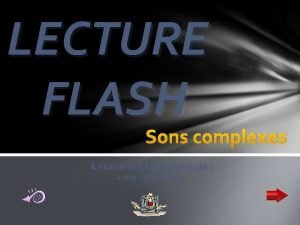Optional Lecture A terse introduction to simplicial complexes








- Slides: 8

Optional Lecture: A terse introduction to simplicial complexes in a series of preparatory lectures for the Fall 2013 online course MATH: 7450 (22 M: 305) Topics in Topology: Scientific and Engineering Applications of Algebraic Topology Target Audience: Anyone interested in topological data analysis including graduate students, faculty, industrial researchers in bioinformatics, biology, computer science, cosmology, engineering, imaging, mathematics, neurology, physics, statistics, etc. Isabel K. Darcy Mathematics Department/Applied Mathematical & Computational Sciences University of Iowa http: //www. math. uiowa. edu/~idarcy/Applied. Topology. html

Building blocks for oriented simplicial complex 0 -simplex = vertex = v 1 -simplex = oriented edge = (v 1, v 2) v 1 v 2 e 2 -simplex = oriented face = (v 1, v 2, v 3) v 2 e 1 v 1 e 2 e 3 v 3

Building blocks for oriented simplicial complex 2 -simplex = oriented face = v 2 f = (v 1, v 2, v 3) = (v 2, v 3, v 1) = (v 3, v 1, v 2) e 1 v 1 e 2 e 3 – f = (v 2, v 1, v 3) = (v 3, v 2, v 1) = (v 1, v 3, v 2) v 2 e 1 v 3 e 2 e 3 v 3

Building blocks for oriented simplicial complex 3 -simplex = σ = (v 1, v 2, v 3, v 4) = (v 2, v 3, v 1, v 4) = (v 3, v 1, v 2, v 4) = (v 2, v 1, v 4, v 3) = (v 3, v 2, v 4, v 1) = (v 1, v 3, v 4, v 2) = (v 4, v 2, v 1, v 3) = (v 4, v 3, v 2, v 1) = (v 4, v 1, v 3, v 2) = (v 1, v 4, v 2, v 3) = (v 2, v 4, v 3, v 1) = (v 3, v 4, v 1, v 2) – σ = (v 2, v 1, v 3, v 4) = (v 3, v 2, v 1, v 4) = (v 1, v 3, v 2, v 4) = (v 2, v 4, v 1, v 3) = (v 3, v 4, v 2, v 1) = (v 1, v 4, v 3, v 2) v 2 = (v 1, v 2, v 4, v 3) = (v 2, v 3, v 4, v 1) = (v 3, v 1, v 4, v 2) = (v 4, v 1, v 2, v 3) = (v 4, v 2, v 3, v 1) = (v 4, v 3, v 1, v 2) v 1 v 3 v 4

Building blocks for oriented simplicial complex 0 -simplex = vertex = v 1 -simplex = oriented edge = (v 1, v 2) Note that the boundary v 1 v 2 of this edge is v – v 2 1 e 2 -simplex = oriented face = (v 1, v 2, v 3) v 2 Note that the boundary of this face is the cycle e 1 e 2 e 1 + e 2 + e 3 v 1 v 3 = (v , v ) + (v , v ) – (v , v ) e 3 1 2 2 3 1 3 = (v 1, v 2) – (v 1, v 3) + (v 2, v 3)

Building blocks for oriented simplicial complex 3 -simplex = (v 1, v 2, v 3, v 4) = tetrahedron v 2 v 4 v 1 v 3 boundary of (v 1, v 2, v 3, v 4) = – (v 1, v 2, v 3) + (v 1, v 2, v 4) – (v 1, v 3, v 4) + (v 2, v 3, v 4) n-simplex = (v 1, v 2, …, vn+1)

Building blocks for an unoriented simplicial complex using Z 2 coefficients 0 -simplex = vertex = v 1 -simplex = edge = {v 1, v 2} v 1 e v 2 Note that the boundary of this edge is v 2 + v 1 2 -simplex = face = {v 1, v 2, v 3} v 2 Note that the boundary of this face is the cycle e 1 e 2 e 1 + e 2 + e 3 v 1 v 3 e 3 = {v 1, v 2} + {v 2, v 3} + {v 1, v 3}

Building blocks for a simplicial complex using Z 2 coefficients 3 -simplex = {v 1, v 2, v 3, v 4} = tetrahedron v 2 v 4 v 1 v 3 boundary of {v 1, v 2, v 3, v 4} = {v 1, v 2, v 3} + {v 1, v 2, v 4} + {v 1, v 3, v 4} + {v 2, v 3, v 4} n-simplex = {v 1, v 2, …, vn+1}














